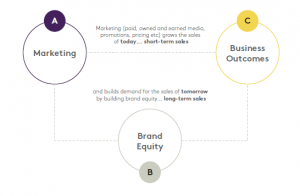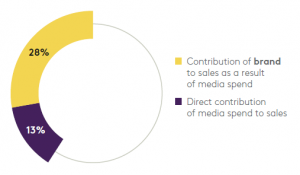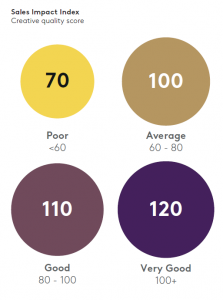
A Model Solution
Measuring Marketing and Media Effectiveness
It’s no secret that marketing delivers sales by creating immediate lifts and building stronger brand equity over time. Both components must be evaluated to fully understand how marketing impacts sales. Creative quality also matters, but is often overlooked when evaluating media effectiveness – a big omission, since there is conclusive evidence that strong creative generates higher ROI. To leverage advertising effectively, you must apply as much focus to what you say as you do to how much you spend.
So, how can you best measure your marketing and media effectiveness? Adopt a holistic effectiveness framework. Brand equity drives sales today, and its effects last for the long term. It accounts for a large part of base sales but is slow to grow or erode. A total marketing return on investment (TMROI) approach:
— Measures each marketing lever in driving direct impact on building brand equity and baseline sales
— Measures the impact of paid media on creating owned and earned media engagement
— Integrates these components to provide a holistic tool to optimise budget allocation
Traditional marketing mix modelling is limited. It mainly quantifies the immediate impact of marketing investment on sales by controlling for other variables, such as seasonality and competitive activity. Brand equity metrics deliver the best surrogate for long-term effects of marketing. Brand equity matters. There’s plenty of evidence of the value of investing in strong brands as a predictor of exceptional business returns.
Seeing the whole picture
The key is understanding what is the impact of equity on sales TODAY

There are three key reasons to include brand equity impacts in assessing marketing effectiveness.
1. Brand equity provides a holistic picture
By quantifying the long-term effects of marketing activity and combining with short-term effects from your mix model, a holistic picture of sales impact and ROI is revealed. Our global TMROI data reveals that on average, media investment helps explain about 13% of short-term sales, but this rises to 28% when including brand impacts. This helps balance performance marketing in the short term and brand building in the long term. And, ultimately, it helps maximise ROI of marketing budgets by driving sales growth today and creating demand tomorrow.
We know brand equity drives a significant part of your sales today

Marketing levers that build brand equity and produce sustainable, long-term effects are generally different from those that drive short-term effects. Balancing the two has major implications for channel and budget allocation.
Marketing levers such as TV, online video, paid social, PR, experiential, and sponsorships are effective and efficient in brand-building; while trade communications and promotions drive short-term effects, yet do little to build brand equity.
So, it’s important to understand the role of your marketing channels and campaigns in driving both short and long-term returns in order to make the best investment.
3. It provides the ‘why’ to the ‘what’
Brand equity data is collected for a range of metrics, from upper-funnel attributes to primary attributes like affinity, brand imagery, and brand awareness. This data offers an understanding of past interactions that created success, and helps predict those that will do so in the future. This knowledge is imperative to guiding brand strategy and providing vital information to diagnose why a marketing or media channel succeeded or failed, and what to focus on to drive equity or sales.
Multiple factors drive media effectiveness, but creative quality is the biggest
Applying a TMROI approach to measure creative effectiveness ensures a holistic view of creative performance and its role in driving media effectiveness. Our Link database of creative testing shows that creative quality can account for as much as 50-60% of total media effectiveness. It amplifies advertising ROIs and drives short- term sales and long-term brand equity. Ultimately, creative driven by higher-quality copy scores leads to higher in- market sales.

Creative quality does not work in isolation
Creative quality can have varying influence on sales, impacted by:
— Advertising objectives
Is the ad trying to generate impact, drive persuasion or build imagery? Importantly, while an ad has not necessarily ‘failed’ because sales don’t immediately or dramatically rise, it very often is an important indicator of sales success, especially because longer-term changes will often start to show up in the shorter term.
— Media strategy
Who are you targeting? How much are you spending? How many people are you reaching? How often is your ad being scheduled? And what length is appropriate? Reaching a sizeable percentage of the target audience as often as possible helps drive broader awareness, and therefore sales.
— Media context
The environment that your ad runs in does impact on its ability to ‘cut through’. The medium is the vehicle to convey the message. The same video ad running on different social media platforms or on different TV program genres will cut through differently.
— Ad message
When the message is generic or similar to that of other brands, it can have little or no impact on sales. For example, refreshment and taste in the beverages category are entry points, not attributes that differentiate your brand.
It is vital that brands measure both short-term effects on sales and longer-term equity to tell a holistic brand story and see the true ROI on their media and marketing decisions. This picture is the roadmap for future media marketing channel decision-making, and a tool for diagnosing why marketing channels have or haven’t been effective. It’s also essential that brands assess the quality of their creative, which is, by far, the biggest driver of media ROIs. It therefore needs to be evaluated in line with a brand’s advertising objectives, media strategy, and message.

Straford Rodrigues
Head of Media and Marketing Effectiveness,
Australia, Kantar
This was first published in the Kantar BrandZ 2023 Most Valuable Brands Report – download it here

